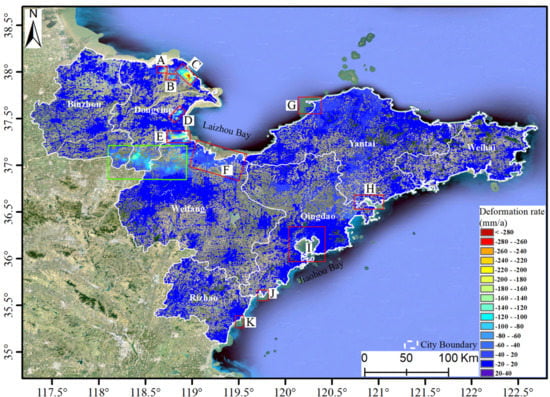Multi-Scale and Multi-Dimensional Time Series InSAR Characterizing of Surface Deformation over Shandong Peninsula, China
Abstract
:1. Introduction
2. Study Area and Geological Settings
3. Data and Methods
3.1. Data
3.2. Methods
3.2.1. 1-D Surface Deformation Derived from SBAS Technique
3.2.2. Multidimensional Small Baseline Subset (MSBAS) Technique
4. Results
4.1. Surface Deformation over The Entire Peninsula
4.2. Accuracy Assessment of The InSAR Measurements
4.3. Deformation Results in The YRD
2-D Deformation Result
5. Discussion
5.1. Correlation between Land Subsidence and Faults
5.2. Land Subsidence in Guangrao Due to Over-Exploitation of Groundwater
5.3. Land Subsidence in Salt Field
5.4. Land Subsidence in Aquaculture Farm
5.5. Land Subsidence Caused by Land Reclamation
6. Conclusions
Author Contributions
Funding
Acknowledgments
Conflicts of Interest
References
- Xu, B.; Feng, G.C.; Li, Z.W.; Wang, Q.J.; Wang, C.C.; Xie, R.G. Coastal Subsidence Monitoring Associated with Land Reclamation Using the Point Target Based SBAS-InSAR Method: A Case Study of Shenzhen, China. Remote Sens. 2016, 8, 652. [Google Scholar] [CrossRef] [Green Version]
- Liu, X.J.; Zhao, C.Y.; Zhang, Q.; Yang, C.S.; Zhang, J. Characterizing and Monitoring Ground Settlement of Marine Reclamation Land of Xiamen New Airport, China with Sentinel-1 SAR Datasets. Remote Sens. 2019, 11, 585. [Google Scholar] [CrossRef] [Green Version]
- Aimaiti, Y.; Yamazaki, F.; Liu, W. Multi-Sensor InSAR Analysis of Progressive Land Subsidence over the Coastal City of Urayasu, Japan. Remote Sens. 2018, 10, 1304. [Google Scholar] [CrossRef] [Green Version]
- Cianflone, G.; Tolomei, C.; Brunori, C.A.; Dominici, R. InSAR Time Series Analysis of Natural and Anthropogenic Coastal Plain Subsidence: The Case of Sibari (Southern Italy). Remote Sens. 2015, 7, 16004–16023. [Google Scholar] [CrossRef] [Green Version]
- Tosi, L.; Lio, C.D.; Teatini, P.; Strozzi, T. Land Subsidence in Coastal Environments: Knowledge Advance in the Venice Coastland by TerraSAR-X PSI. Remote Sens. 2018, 10, 1191. [Google Scholar] [CrossRef] [Green Version]
- Qu, F.F.; Lu, Z.; Kim, J.-W.; Zheng, W.Y. Identify and Monitor Growth Faulting Using InSAR over Northern Greater Houston, Texas, USA. Remote Sens. 2019, 11, 1498. [Google Scholar] [CrossRef] [Green Version]
- Qu, F.F.; Lu, Z.; Zhang, Q.; Bawden, G.W.; Kim, J.-W.; Zhao, C.Y.; Qu, W. Mapping ground deformation over Houston–Galveston, Texas using multi-temporal InSAR. Remote Sens. Environ. 2015, 169, 290–306. [Google Scholar] [CrossRef]
- Dixon, T.H.; Amelung, F.; Ferretti, A.; Novali, F.; Rocca, F.; Dokka, R.; Sella, G.; Kim, S.-W.; Wdowinski, S.; Whitman, D. Space geodesy: Subsidence and flooding in New Orleans. Nature 2006, 441, 587–588. [Google Scholar] [CrossRef] [PubMed]
- Higgins, S.; Overeem, I.; Tanaka, A.; Syvitski, J.P.M. Land subsidence at aquaculture facilities in the Yellow River delta, China. Geophys. Res. Lett. 2013, 40, 3898–3902. [Google Scholar] [CrossRef]
- Zhang, J.Z.; Huang, H.J.; Bi, H.B. Land subsidence in the modern Yellow River delta based on InSAR time series analysis. Nat. Hazards 2015, 75, 2385–2397. [Google Scholar] [CrossRef]
- Liu, Y.L.; Huang, H.J.; Dong, J.F. Large-area land subsidence monitoring and mechanism research using the small baseline subset interferometric synthetic aperture radar technique over the Yellow River Delta, China. J. Appl. Remote Sens. 2015, 9, 096019. [Google Scholar] [CrossRef]
- Zhang, X.Y.; Miao, J.J.; Hu, B.X.; Liu, H.W.; Zhang, H.X.; Ma, Z. Hydrogeochemical characterization and groundwater quality assessment in intruded coastal brine aquifers (Laizhou Bay, China). Environ. Sci. Pollut. R. 2017, 24, 21073–21090. [Google Scholar] [CrossRef] [PubMed]
- Liu, P.; Li, Q.Q.; Li, Z.H.; Hoey, T.; Liu, Y.X.; Wang, C.S. Land Subsidence over Oilfields in the Yellow River Delta. Remote Sens. 2015, 7, 1540–1564. [Google Scholar] [CrossRef] [Green Version]
- Liu, Y.L.; Huang, H.J.; Liu, Y.X.; Bi, H.B. Linking land subsidence over the Yellow River delta, China, to hydrocarbon exploitation using multi-temporal InSAR. Nat. Hazards 2016, 84, 271–291. [Google Scholar] [CrossRef]
- Sun, Q.S.; Jiang, L.M.; Jiang, M.; Lin, H.; Ma, P.F.; Wang, H.S. Monitoring Coastal Reclamation Subsidence in Hong Kong with Distributed Scatterer Interferometry. Remote Sens. 2018, 10, 1738. [Google Scholar] [CrossRef] [Green Version]
- Yang, M.S.; Yang, T.L.; Zhang, L.; Lin, J.X.; Qin, X.Q.; Liao, M.S. Spatial-Temporal Characterization of a Reclamation Settlement in the Shanghai Coastal Area with Time Series Analyses of X-, C-, and L-band SAR datasets. Remote Sens. 2018, 10, 329. [Google Scholar] [CrossRef] [Green Version]
- Bamler, R.; Hartl, P. Synthetic aperture radar interferometry. Inverse Probl. 1998, 14, R1–R54. [Google Scholar] [CrossRef]
- Massonnet, D.; Feigl, K. Radar interferometry and its application to changes in the Earth’s surface. Rev. Geophys. 1998, 36, 441–500. [Google Scholar] [CrossRef] [Green Version]
- Ferretti, A.; Prati, C.; Rocca, F. Permanent scatterers in SAR interferometry. IEEE Trans. Geosci. Remote Sens. 2001, 39, 8–20. [Google Scholar] [CrossRef]
- Berardino, P.; Fornaro, G.; Lanari, R.; Sansoto, E. A new algorithm for surface deformation monitoring based on small baseline differential SAR interferograms. IEEE Trans. Geosci. Remote Sens. 2002, 40, 2375–2383. [Google Scholar] [CrossRef] [Green Version]
- Wang, H.; Wright, T.J.; Yu, Y.P.; Lin, H.; Jiang, L.L.; Li, C.H.; Qiu, G.X. InSAR reveals coastal subsidence in the Pearl River Delta, China. Geophys. J. Int. 2012, 191, 1119–1128. [Google Scholar] [CrossRef] [Green Version]
- Du, Y.N.; Feng, G.C.; Peng, X.; Li, Z.W. Subsidence Evolution of the Leizhou Peninsula, China, Based on InSAR Observation from1992 to 2010. Appl. Sci. 2017, 7, 466–484. [Google Scholar] [CrossRef] [Green Version]
- Bartsch, A.; Leibman, M.; Strozzi, T.; Khomutov, A.; Widhalm, B.; Babkina, E.; Mullanurov, D.; Ermokhina, K.; Kroisleitner, C.; Bergstedt, H. Seasonal Progression of Ground Displacement Identified with Satellite Radar Interferometry and the Impact of Unusually Warm Conditions on Permafrost at the Yamal Peninsula in 2016. Remote Sens. 2019, 11, 1865. [Google Scholar] [CrossRef] [Green Version]
- Zinno, I.; Bonano, M.; Buonanno, S.; Casu, F.; De, L.C.; Manunta, M.; Lanari, R. National Scale Surface Deformation Time Series Generation through Advanced DInSAR Processing of Sentinel-1 Data within a Cloud Computing Environment. IEEE Trans. Big Data 2018. [Google Scholar] [CrossRef] [Green Version]
- Zhang, Y.; Huang, H.J.; Liu, Y.L.; Liu, Y.X.; Bi, H.B. Spatial and temporal variations in subsidence due to the natural consolidation and compaction of sediment in the yellow river delta, China. Mar. Georesour. Geotec. 2019, 37, 152–163. [Google Scholar] [CrossRef]
- Zhang, B.W.; Wang, R.; Deng, Y.K.; Ma, P.F.; Lin, H.; Wang, J.L. Mapping the Yellow River Delta land subsidence with multitemporal SAR interferometry by exploiting both persistent and distributed scatterers. ISPRS J. Photogramm. Remote Sens. 2019, 148, 157–173. [Google Scholar] [CrossRef]
- Xu, Y. Study on Comprehensive Development and Utilization Mode and the Distribution Law of Underground Brine Resources in the Yellow River Delta. Master’s Dissertation, Qingdao University, Qingdao, China, 2013. (In Chinese). [Google Scholar]
- Guo, Q.C.; Zheng, Z.; Huang, L.M.; Deng, A. Regularity of sediment transport and sedimentation during floods in the lower Yellow River, China. Int. J. Sediment Res. 2020, 35, 97–104. [Google Scholar] [CrossRef]
- Yin, Y.H. A discussion on land reclamation along the coast of Shandong and its problems. Mar. Geol. Lett. 2010, 26, 35–39. (In Chinese) [Google Scholar]
- Farr, T.G.; Rosen, P.A.; Caro, E.; Crippen, R.; Duren, R.; Hensley, S.; Kobrick, M.; Paller, M.; Rodriguez, E.; Roth, L.; et al. The shuttle radar topography mission. Rev. Geophys. 2007, 45, 1–33. [Google Scholar] [CrossRef] [Green Version]
- Lanari, R.; Mora, O.; Manunta, M.; Mallorqui, J.J.; Berardino, P.; Sansosti, E. A small-baseline approach for investigating deformations on full-resolution differential SAR interferograms. IEEE Trans. Geosci. Remote Sens. 2004, 42, 1377–1386. [Google Scholar] [CrossRef]
- Werner, C.; Wegmüller, U.; Strozzi, T.; Wiesmann, A. GAMMA SAR and interferometric processing software. In Proceedings of the ERS-Envisat Symposium, Gothenburg, Sweden, 16–20 October 2000. [Google Scholar]
- Goldstein, R.; Engelhardt, H.; Kamb, B.; Frolich, R. Satellite radar interferometry for monitoring ice sheet motion: Application to an Antarctic ice stream. Science 1993, 262, 1525–1530. [Google Scholar] [CrossRef] [PubMed]
- Samsonov, S.; d’Oreye, N. Multidimensional Small Baseline Subset (MSBAS) for Two-Dimensional Deformation Analysis: Case Study Mexico City. Can. J. Remote Sens. 2017, 43, 318–329. [Google Scholar] [CrossRef]
- Samsonov, S.; d’Oreye, N. Multidimensional time series analysis of ground deformation form multiple InSAR data sets applied to Virunga Volcanic Province. Geophys. J. Int. 2012, 191, 1095–1108. [Google Scholar]
- Samsonov, S.; d’Oreye, N.; Smets, B. Ground deformation associated with post-mining active at the French-German border revealed by novel InSAR time series method. Int. J. Appl. Earth Obs. Geoinf. 2013, 23, 142–154. [Google Scholar] [CrossRef]
- Samsonov, S.; Tiampo, K.; Camacho, A.; Fernandez, J.; Gonzalez, P. Spatiotemporal analysis and interpretation of 1993–2013 ground deformation at Campi Flegrei, Italy, observed by advanced DInSAR. Geophys. Res. Lett. 2014, 41, 6101–6108. [Google Scholar] [CrossRef] [Green Version]
- Guo, C.X.; Nie, J.L.; Tian, J.; Wang, W.L.; Cheng, C.L.; Wang, B.; Yin, H.F.; Zhang, H.P. Vertical ground displacements in the Shandong Province derived from long-term GNSS and leveling surveying. Adv. Space Res. 2019, 64, 1388–1397. [Google Scholar] [CrossRef]
- Peng, M.M.; Zhao, C.Y.; Zhang, Q.; Lu, Z.; Li, Z.S. Research on Spatiotemporal Land Deformation (2012–2018) over Xi’an, China, with Multi-Sensor SAR Datasets. Remote Sens. 2019, 11, 664. [Google Scholar] [CrossRef] [Green Version]
- Yang, C.S.; Lu, Z.; Zhang, Q.; Liu, R.C.; Ji, L.Y.; Zhao, C.Y. Ground deformation and fissure activity in Datong basin, China 2007–2010 revealed by multi-track InSAR. Geomat. Nat. Haz. Risk 2019, 10, 465–482. [Google Scholar] [CrossRef]
- Chaussard, E.; Wdowinski, S.; Cabral-Cano, E.; Amelung, F. Land subsidence in central Mexico detected by ALOS InSAR time series. Remote Sens. Environ. 2014, 140, 94–106. [Google Scholar] [CrossRef]
- Wu, X.M.; Yu, G.M.; Teng, W.G. Study on the features of fault distribution of urban agglomeration areas in Shandong peninsula. J. Qingdao Univ. Technol. 2011, 32, 60–65. (In Chinese) [Google Scholar]
- Luo, W.Q.; Zhang, S.K.; Yu, X.F.; Tian, J.X.; Yang, B.; Zhang, Y.; Chen, J.; Ma, X.X.; Tang, L.L.; Sun, X.Z. Review on research progress of Yishu fault zone. Shandong Land Resour. 2018, 34, 59–65. (In Chinese) [Google Scholar]
- Li, J.; Yu, C.; Zhu, C.L.; Jia, Y.; Feng, Z.J.; Han, H.H. Vertical deformation characteristics of the Yishu fault zone and its nearby area. Earthquake 2018, 38, 167–177. (In Chinese) [Google Scholar]
- Zou, Z.G.; Zhang, D.S.; Tan, Z.R. Ground Brine Resource and Its Exploitation in Shandong Province. Geol. Surv. Res. 2008, 31, 214–221. (In Chinese) [Google Scholar]
- Chang, Y.W.; Hu, B.X.; Xu, Z.X.; Li, X.; Tong, J.X.; Chen, L.; Zhang, H.X.; Miao, J.J.; Liu, H.W.; Ma, Z. Numerical simulation of seawater intrusion to coastal aquifers and brine water/freshwater interaction in south coast of Laizhou Bay, China. J. Contam. Hydrol. 2018, 215, 1–10. [Google Scholar] [CrossRef] [PubMed] [Green Version]
- Terzaghi, K.; Peck, R.; Mesri, G. Soil Mechanics in Engineering Practice; John Wiley and Sons: Hoboken, NJ, USA, 1996; pp. 1–592. [Google Scholar]
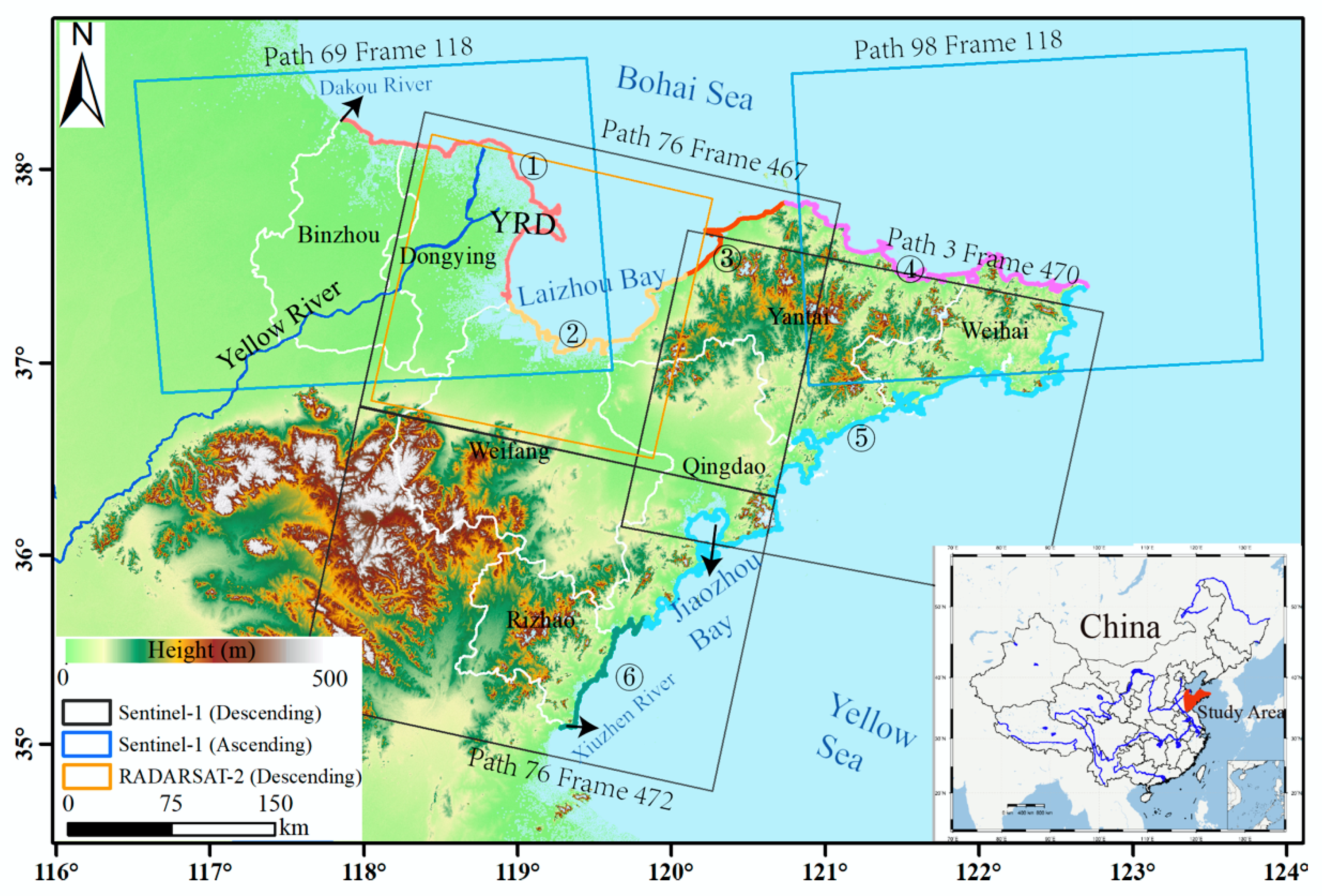
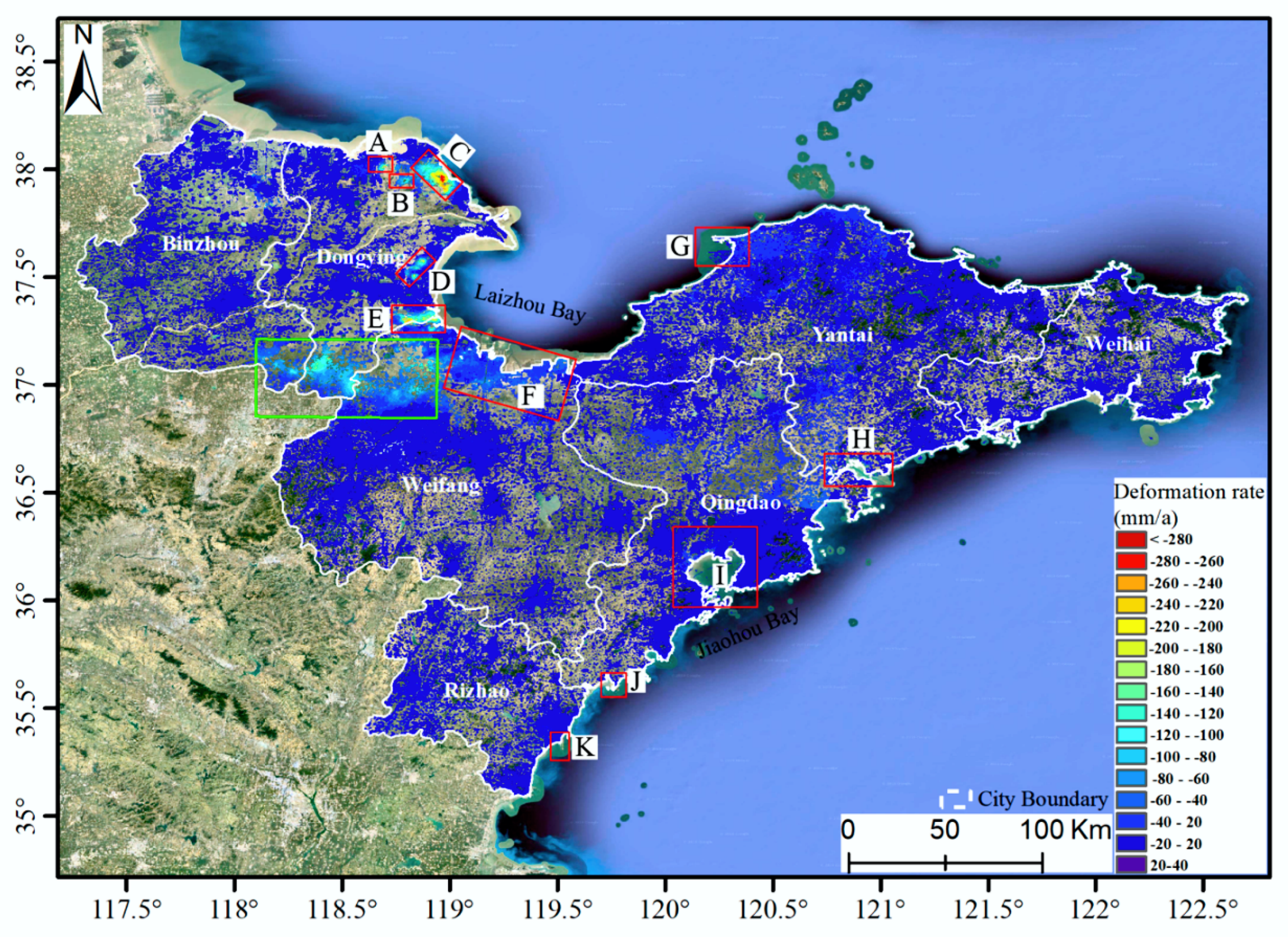
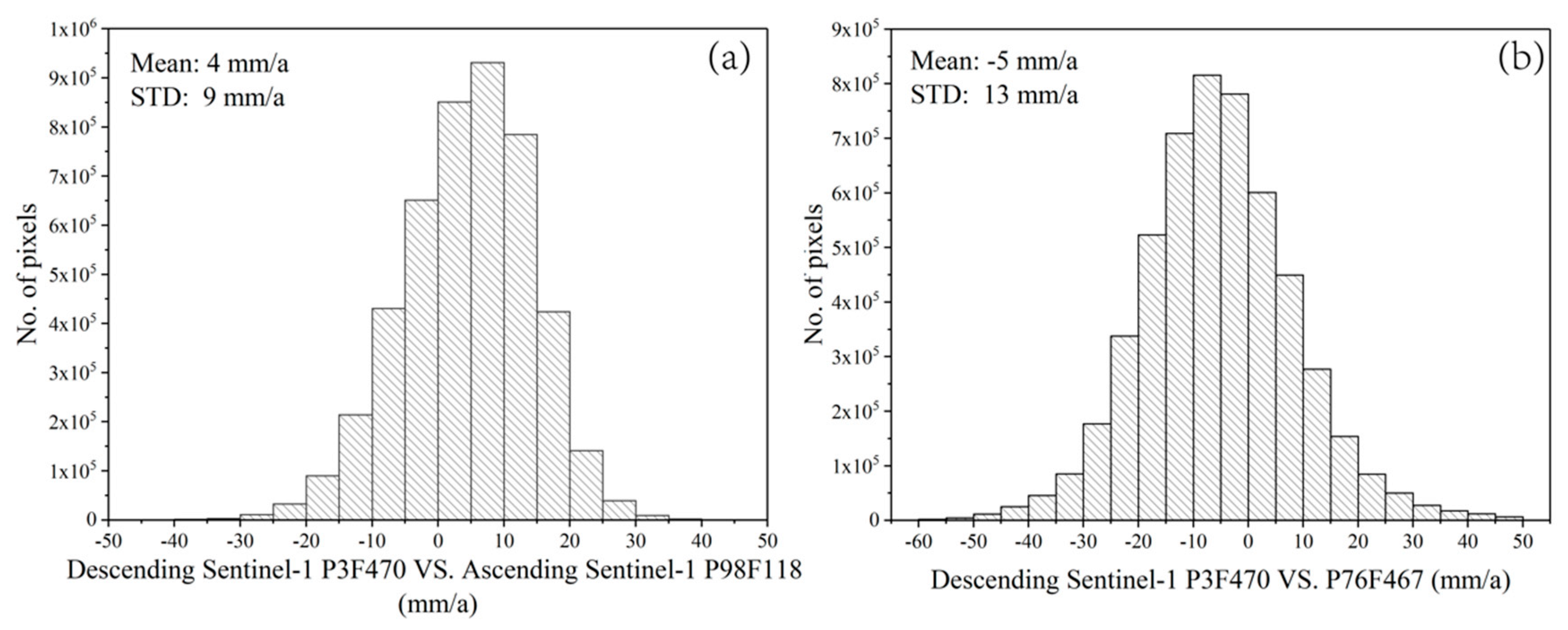
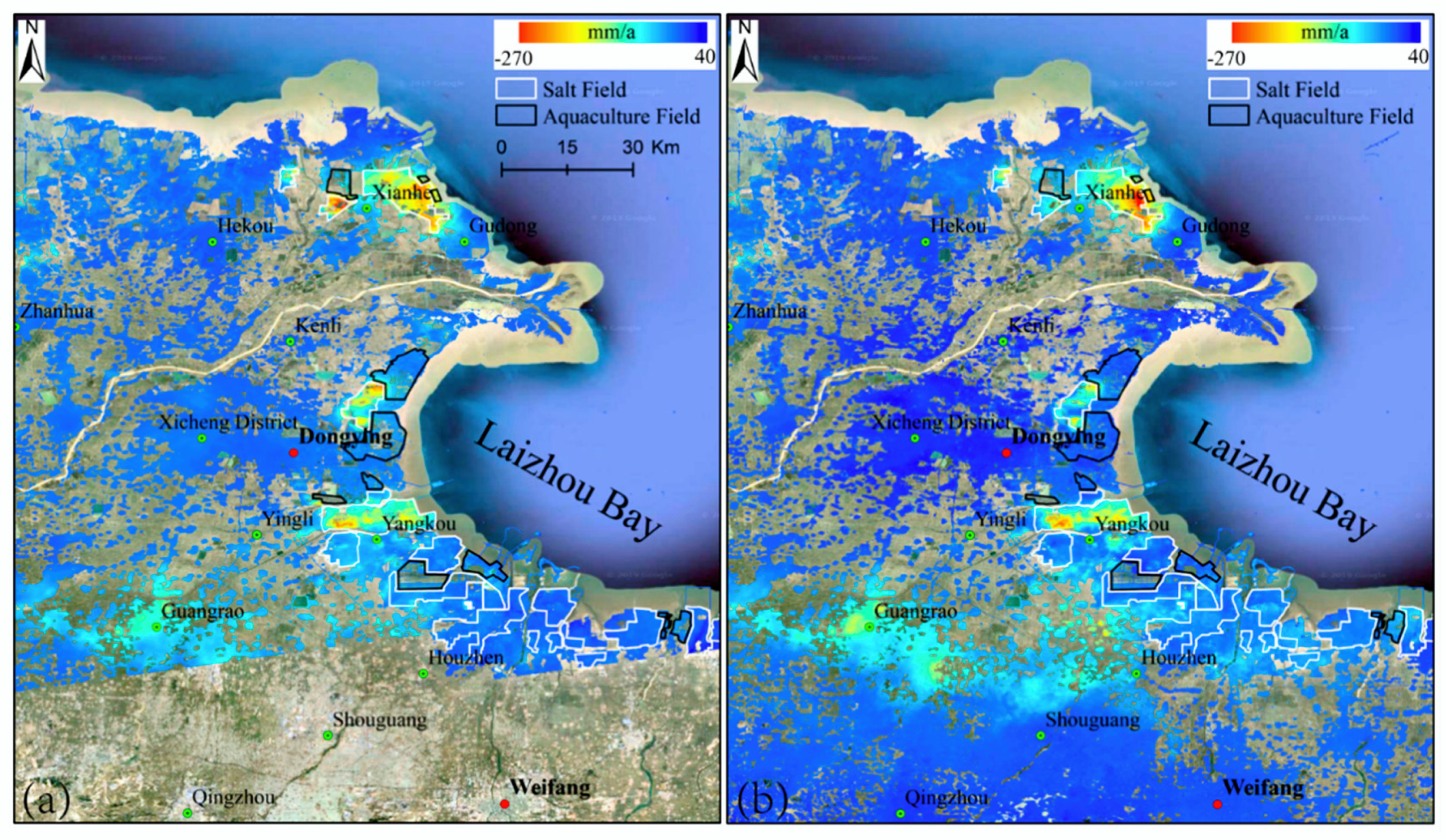
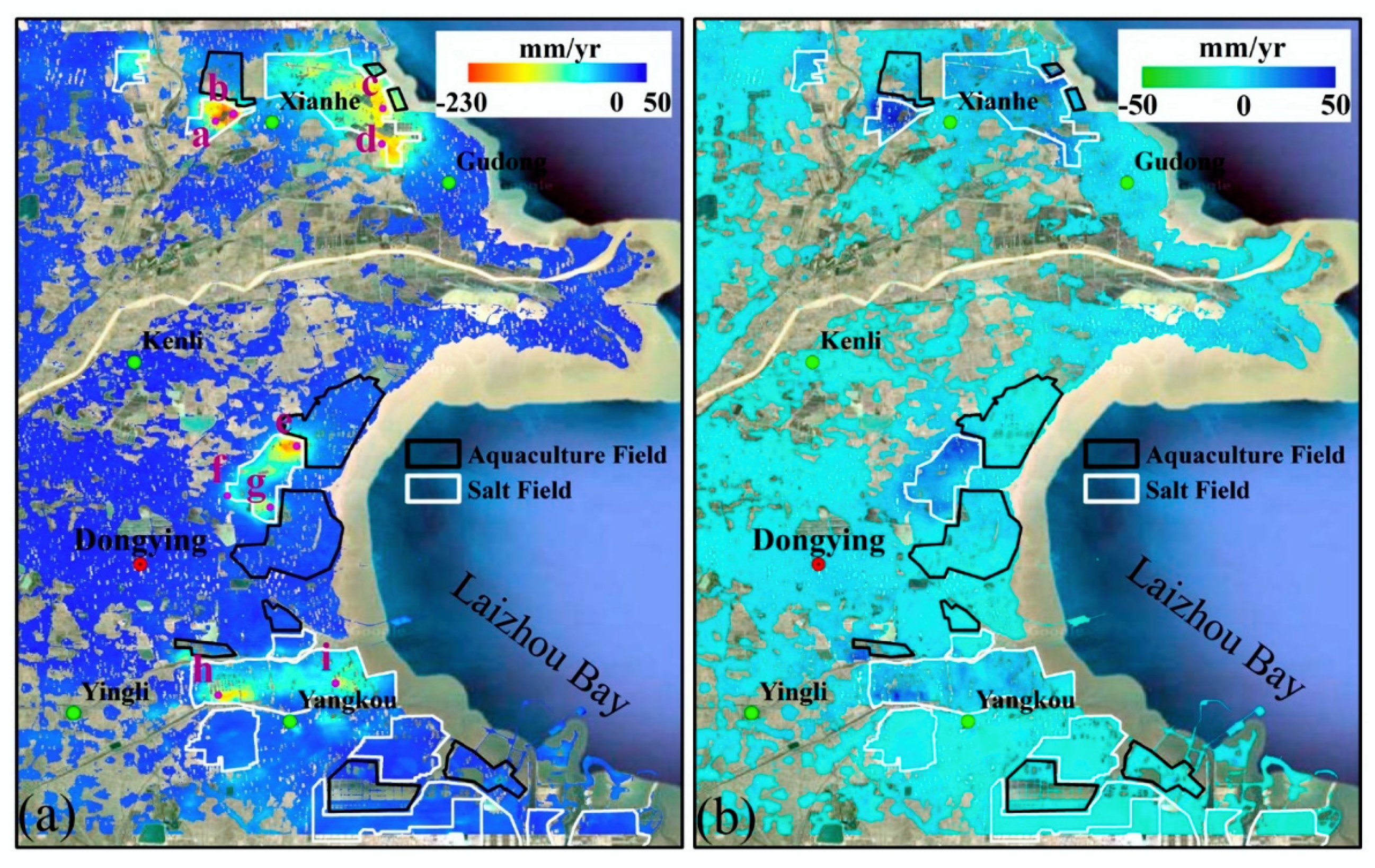
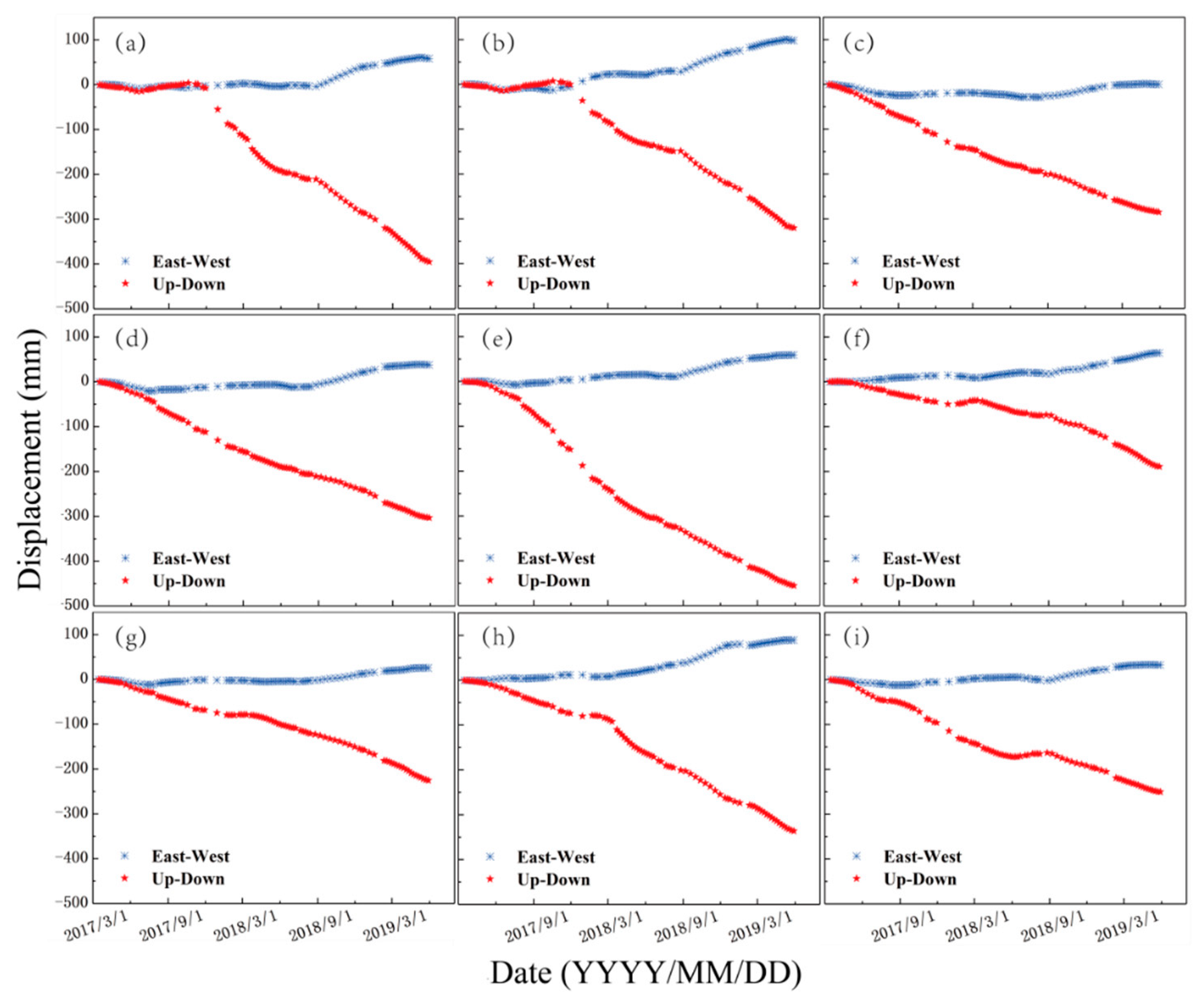
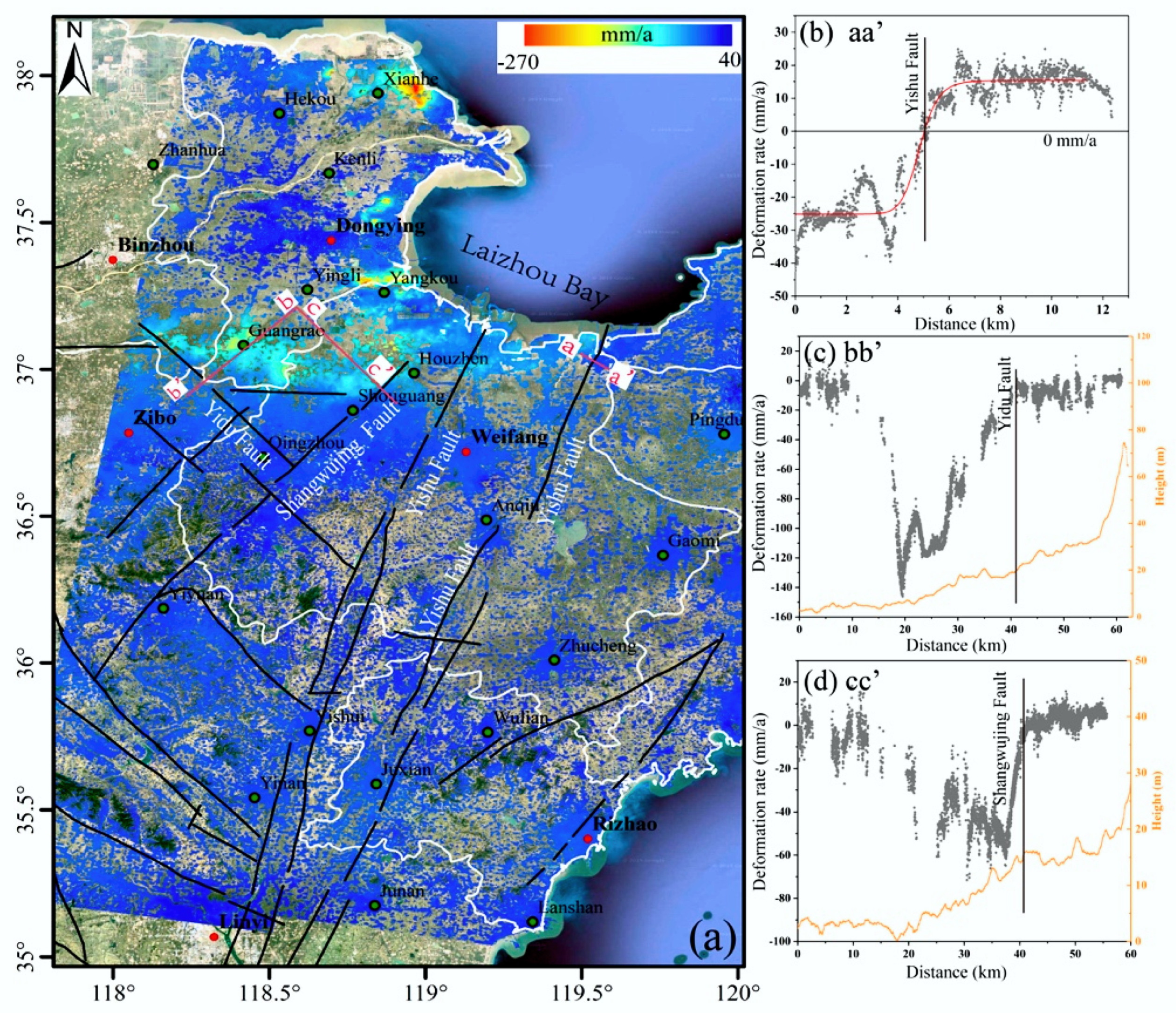
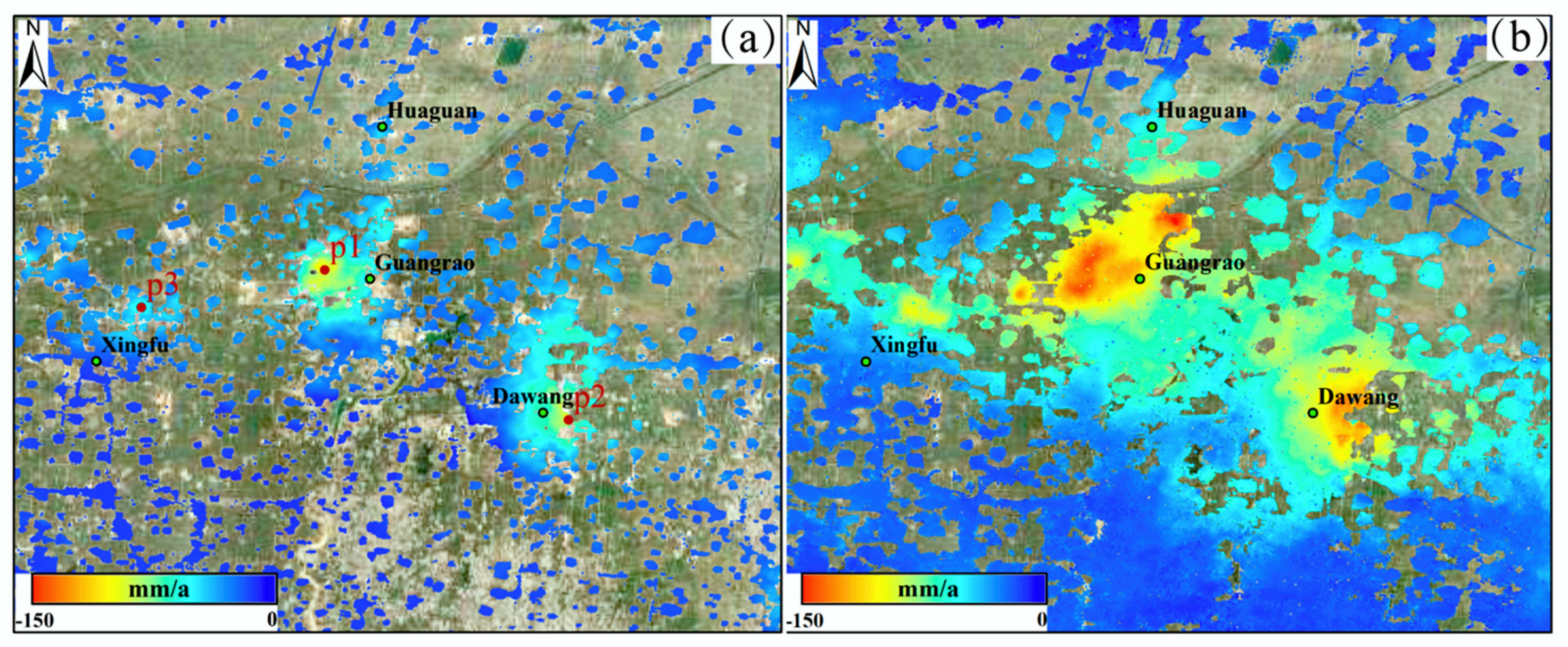
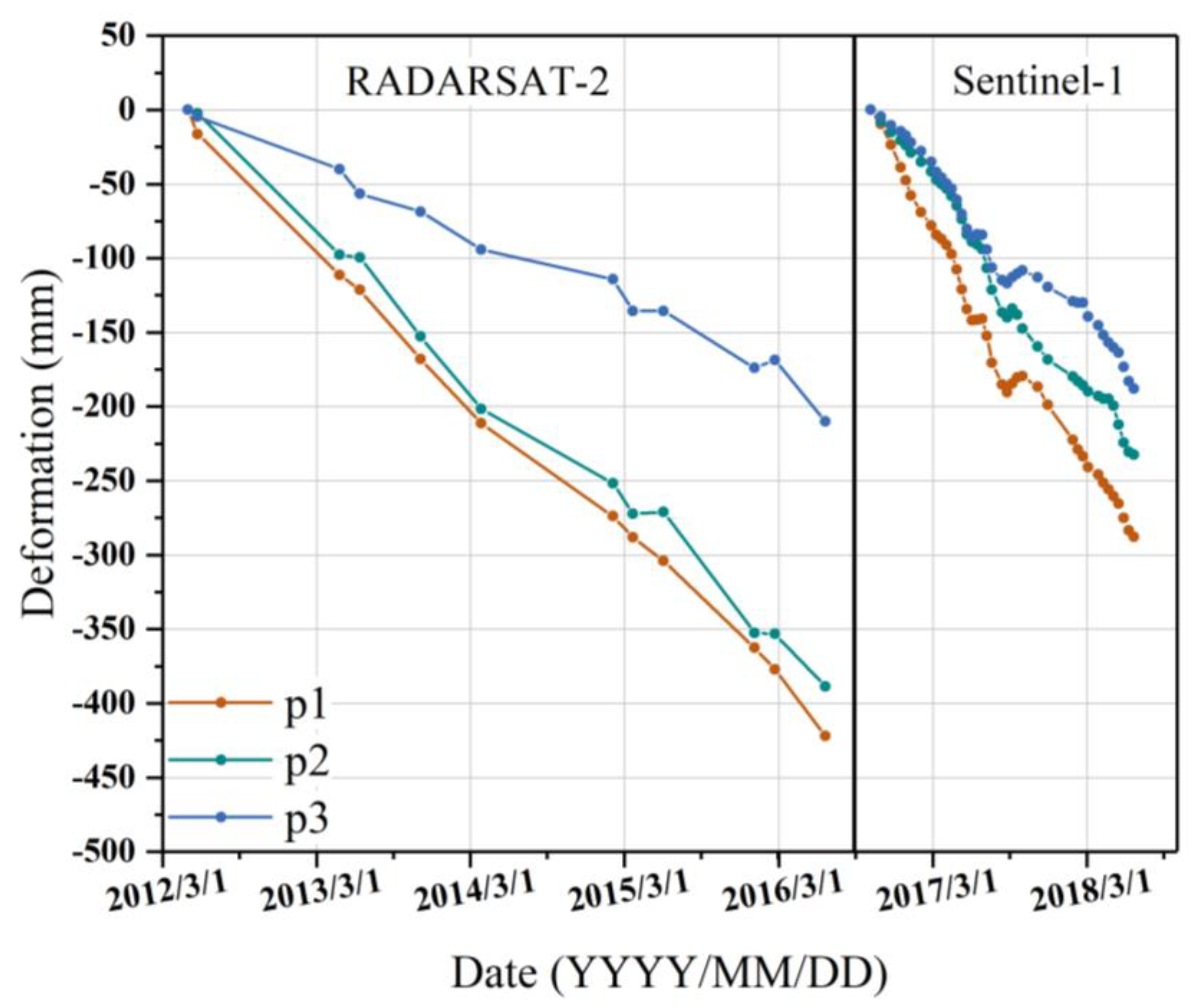


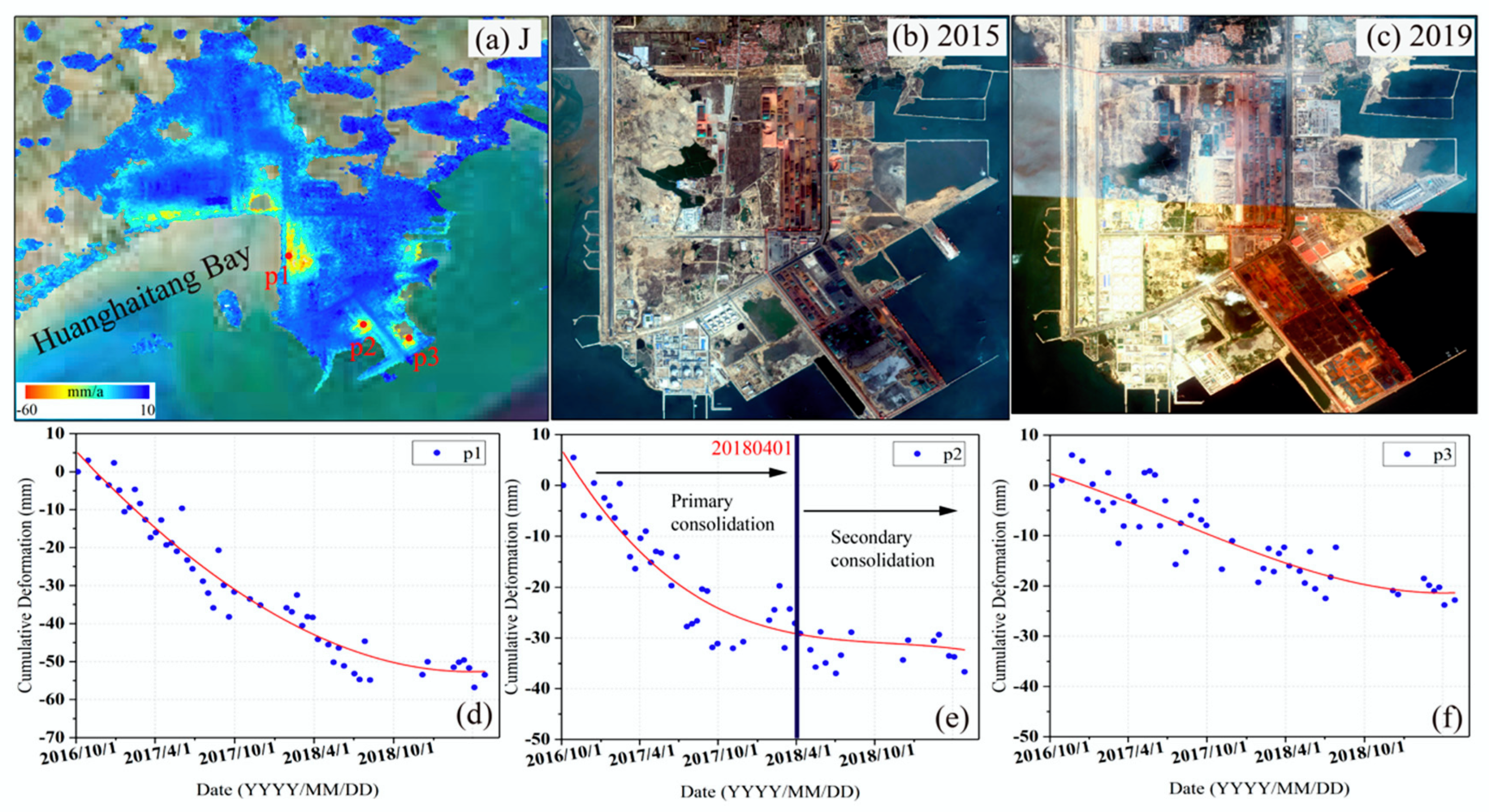

| Satellite | Orbit Direction | Path/Track | Frame | Scene Numbers | Time Interval | Incidence Angle |
|---|---|---|---|---|---|---|
| Sentinel-1A/B (C-Band) | Ascending | 98 | 118 | 56 | 2017/04–2019/03 | 33.75 |
| 69 | 118 | 66 | 2017/03–2019/05 | 33.73 | ||
| Descending | 3 | 470 | 50 | 2017/04–2019/03 | 34.08 | |
| 76 | 468 | 33 | 2016/10–2019/02 | 33.91 | ||
| 76 | 472 | 54 | 2016/10–2017/04 | 33.95 | ||
| RADARSAT-2 (C-Band) | Descending | / | / | 12 | 2012/04–2016/06 | 26.23 |
| City | Location | Lat/Lon | Corresponding Region | Period | Maximum Magnitude (cm/a) | Size (km2) (>2cm/a) | Cause |
|---|---|---|---|---|---|---|---|
| Dongying, Weifang | YRD (coastal area) | / | A, B, C, D, E, F | 201204–201907 | 29 | 522 | Brine withdrawal |
| Yantai, Qingdao | Dingzi Bay, Jiaozhou Bay | N36.6E120.8 /N36.2E120.1 | H, I | 201610–201904 | 7 | 166 | Aquaculture |
| Yantai, Qingdao, Rizhao | / | N37.6E120.2/ N35.6E119.7/ N35.3E119.5 | G, J, K | 201610–201904 | 6 | 15 | Land reclamation, Sediment consolidation |
| Dongying | Guangrao | N37.05E118.4 | / | 201610–201907 | 14 | 730 | groundwater withdrawal, fault |
© 2020 by the authors. Licensee MDPI, Basel, Switzerland. This article is an open access article distributed under the terms and conditions of the Creative Commons Attribution (CC BY) license (http://creativecommons.org/licenses/by/4.0/).
Share and Cite
Peng, M.; Zhao, C.; Zhang, Q.; Lu, Z.; Bai, L.; Bai, W. Multi-Scale and Multi-Dimensional Time Series InSAR Characterizing of Surface Deformation over Shandong Peninsula, China. Appl. Sci. 2020, 10, 2294. https://doi.org/10.3390/app10072294
Peng M, Zhao C, Zhang Q, Lu Z, Bai L, Bai W. Multi-Scale and Multi-Dimensional Time Series InSAR Characterizing of Surface Deformation over Shandong Peninsula, China. Applied Sciences. 2020; 10(7):2294. https://doi.org/10.3390/app10072294
Chicago/Turabian StylePeng, Mimi, Chaoying Zhao, Qin Zhang, Zhong Lu, Lin Bai, and Weiming Bai. 2020. "Multi-Scale and Multi-Dimensional Time Series InSAR Characterizing of Surface Deformation over Shandong Peninsula, China" Applied Sciences 10, no. 7: 2294. https://doi.org/10.3390/app10072294
APA StylePeng, M., Zhao, C., Zhang, Q., Lu, Z., Bai, L., & Bai, W. (2020). Multi-Scale and Multi-Dimensional Time Series InSAR Characterizing of Surface Deformation over Shandong Peninsula, China. Applied Sciences, 10(7), 2294. https://doi.org/10.3390/app10072294






